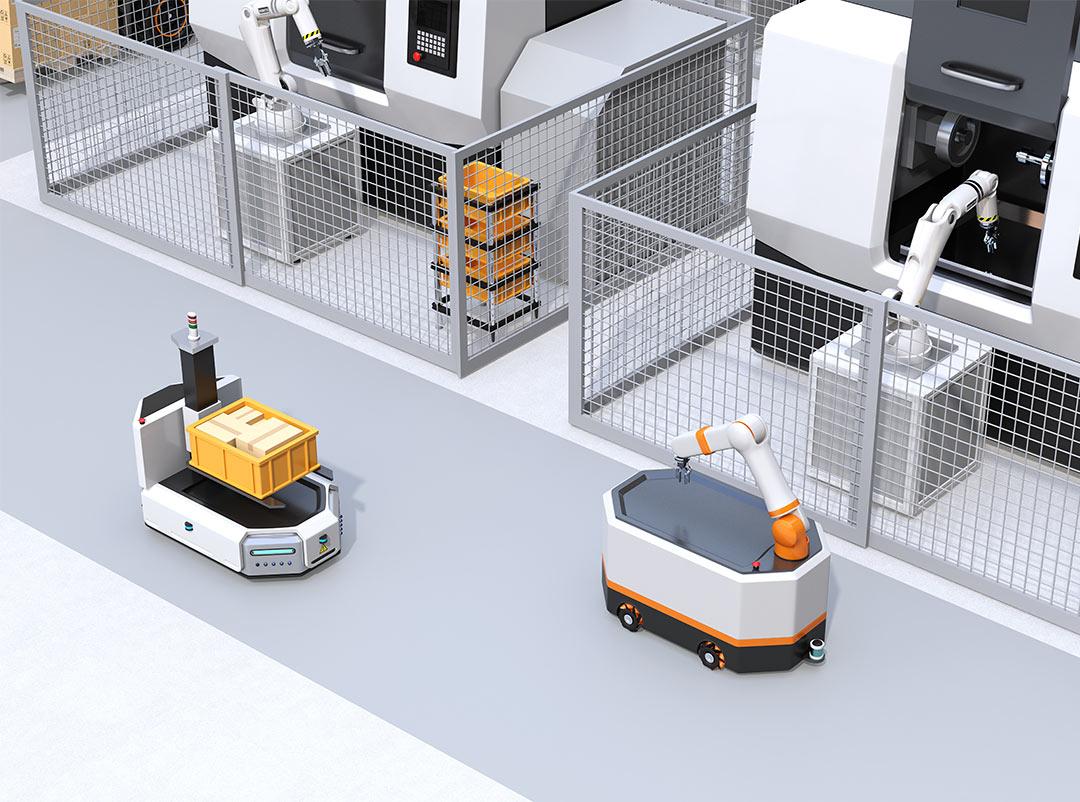
Some common robot terminology — what is the difference between a robot and an autonomous machine?
Autonomous machines and self-driving cars receive a lot of media attention and the buzz around the topic is big. The terminology is not always very clear – what is the difference between a robot and an autonomous machine – or is there any? Are AGVs and IAVs the same thing?
This blog post covers some of the most common terms around the topic. Here we go:
AGV. Automated Guided Vehicle or Automatic Guided Vehicle is a machine used for material handling operations in warehouses and factories. Typical AGVs move automatically pallets, raw materials, bins, carts, containers etc. from one place to another without direct human operation. Older models follow the marked lines or wires on the floor, newer AGV systems use cameras, magnets, lidars or radio waves for navigation.
AMR. Sometimes term AMR – Autonomous Mobile Robot – is used to differentiate traditional AGVs from more intelligent material handling machines. AMRs are not dependent on physical wires or floor markings to navigate. They have advanced sensor systems and capability to dynamically plan their routes according to the surrounding environment and traffic situation. Path planning and decision making can take place in the AMRs on-board computer or in the server controlling the AMR fleet. Anyway, many modern AGV systems have similar capabilities than AMRs, so the difference between AGVs and AMRs is not very clear.
Autonomous machine. Autonomous Machine can sense its environment and adapt its operation accordingly. Sometimes terms automatic and autonomous are used interchangeably, but the terms have a difference. While automatic machine performs its tasks according to the pre-defined rules, autonomous machine can learn from its surroundings and decide independently how to act.
Autonomous Vehicle. Autonomous vehicle (or AV) is often used as a synonym for an autonomous car – a car that can navigate and drive without human operator. Autonomous Vehicles cover also wider set of machines than just passenger cars. Autonomous Vehicles are used also for example in logistics for autonomous material handling operations. Vehicle autonomy level is defined at six levels, see below the term Level of autonomy.
Cobot is an acronym for collaborative robot. Typically industrial robots work on the restricted areas, where humans are not allowed to go while robot is working. Cobots can instead work simultaneously with humans in the same place. Safety is taken care by software and sensors or by limiting the speed and force of the cobot.
Fleet. Fleet in this context is a set of robots working in the same location. Robot fleet is usually managed by Fleet Controller or Fleet management system.
Fleet Management System is a software system controlling the robot fleet. Fleet management system monitors the position, battery level and condition of individual robots, receives tasks from ERP or WMS (Warehouse Management System), schedules the tasks and allocates them to the robots. Fleet management system plans routes, detects possible bottlenecks and optimizes the operation of the entire robot fleet.
IAV. Industrial Autonomous Vehicle is an autonomous machine used in industry. IAV term is often used as a synonym for an autonomous machine.
Level of autonomy. Standard developing organization SAE International has defined six levels of vehicle automation:
- Level 0: No automation. Vehicle is controlled manually. Level 0 vehicles may be have some features helping the driver, like automatic emergency braking.
- Level 1: Driver assistance. This level of automation includes features that dynamically control the vehicle and assist the driver. Currently many new cars have level 1 autonomy features, like adaptive cruise control or automatic lane keeping system. Level 1 autonomy controls either the steering or the speed of the vehicle, but not both at the same time.
- Level 2: Partial driving automation. Acronym ADAS (Advanced Driver Assistance System) is often used with level 2 autonomous vehicles. The system can control simultaneously both speed and steering. Tesla and some other modern cars have level 2 autonomy.
- Level 3: Conditional automation. Driver can let the car do the driving on some special conditions, like on highway or traffic jam, but must be ready to take control when needed.
- Level 4: High automation. Level 4 autonomous vehicle can handle the driving in more complex situations and take care of speed, steering, turning signals etc. If the driving conditions change for example due to heavy rain or snowstorm, the vehicle can alert the driver to take control. If the driver does not respond, the vehicle can slow the speed and park the vehicle.
- Level 5: Full autonomy. The vehicle can operate in all conditions.
Robot is a machine or system that can perform tasks without direct human control. Robot can have various levels of autonomous capabilities, but autonomous features are not mandatory. Traditional industrial robots perform pre-defined tasks, like welding or assembling with little or no autonomous capabilities. On the other end are highly advanced robots, such as Boston Dynamics robots, with very sophisticated sensors and algorithms that help them learn and adjust their operation to the environment.
Swarm. Robot swarm can be sometimes used as a synonym for robot fleet, but often robot swarm is associated with swarm intelligence. This means that robots in the swarm can collect and share information with each other and function together more intelligently than individual robots alone.
There are certainly more terms to cover, but here is a small sample for starters.

Markku Haukijärvi
Sales